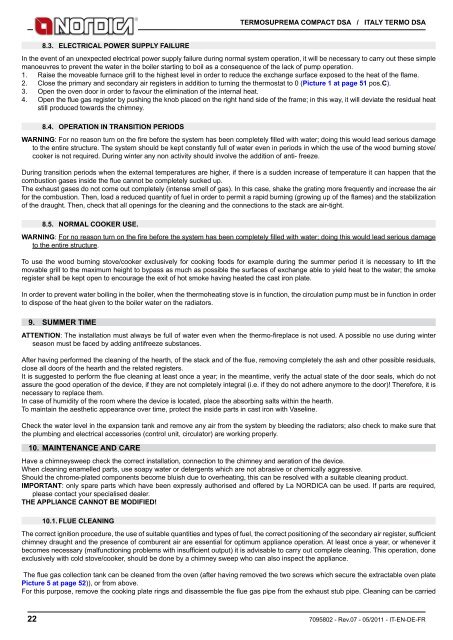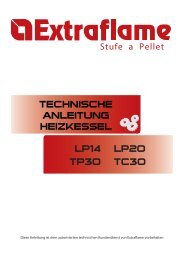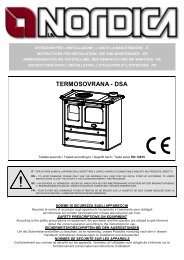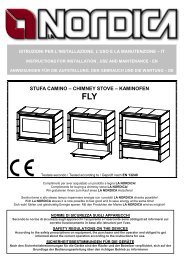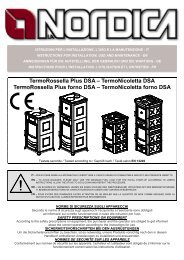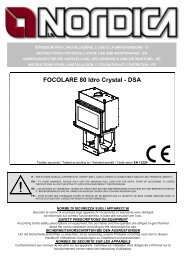1 - HJS-Internethandel
1 - HJS-Internethandel
1 - HJS-Internethandel
You also want an ePaper? Increase the reach of your titles
YUMPU automatically turns print PDFs into web optimized ePapers that Google loves.
TERMOSUPREMA COMPACT DSA / ITALY TERMO DSA<br />
8.3. ELECTRICAL POWER SUPPLY FAILURE<br />
In the event of an unexpected electrical power supply failure during normal system operation, it will be necessary to carry out these simple<br />
manoeuvres to prevent the water in the boiler starting to boil as a consequence of the lack of pump operation.<br />
1. Raise the moveable furnace grill to the highest level in order to reduce the exchange surface exposed to the heat of the flame.<br />
2. Close the primary and secondary air registers in addition to turning the thermostat to 0 (Picture 1 at page 51 pos.C).<br />
3. Open the oven door in order to favour the elimination of the internal heat.<br />
4. Open the flue gas register by pushing the knob placed on the right hand side of the frame; in this way, it will deviate the residual heat<br />
still produced towards the chimney.<br />
8.4. OPERATION IN TRANSITION PERIODS<br />
WARNING: For no reason turn on the fire before the system has been completely filled with water; doing this would lead serious damage<br />
to the entire structure. The system should be kept constantly full of water even in periods in which the use of the wood burning stove/<br />
cooker is not required. During winter any non activity should involve the addition of anti- freeze.<br />
During transition periods when the external temperatures are higher, if there is a sudden increase of temperature it can happen that the<br />
combustion gases inside the flue cannot be completely sucked up.<br />
The exhaust gases do not come out completely (intense smell of gas). In this case, shake the grating more frequently and increase the air<br />
for the combustion. Then, load a reduced quantity of fuel in order to permit a rapid burning (growing up of the flames) and the stabilization<br />
of the draught. Then, check that all openings for the cleaning and the connections to the stack are air-tight.<br />
8.5. NORMAL COOKER USE.<br />
WARNING: For no reason turn on the fire before the system has been completely filled with water; doing this would lead serious damage<br />
to the entire structure.<br />
To use the wood burning stove/cooker exclusively for cooking foods for example during the summer period it is necessary to lift the<br />
movable grill to the maximum height to bypass as much as possible the surfaces of exchange able to yield heat to the water; the smoke<br />
register shall be kept open to encourage the exit of hot smoke having heated the cast iron plate.<br />
In order to prevent water boiling in the boiler, when the thermoheating stove is in function, the circulation pump must be in function in order<br />
to dispose of the heat given to the boiler water on the radiators.<br />
9. SUMMER TIME<br />
ATTENTION: The installation must always be full of water even when the thermo-fireplace is not used. A possible no use during winter<br />
season must be faced by adding antifreeze substances.<br />
After having performed the cleaning of the hearth, of the stack and of the flue, removing completely the ash and other possible residuals,<br />
close all doors of the hearth and the related registers.<br />
It is suggested to perform the flue cleaning at least once a year; in the meantime, verify the actual state of the door seals, which do not<br />
assure the good operation of the device, if they are not completely integral (i.e. if they do not adhere anymore to the door)! Therefore, it is<br />
necessary to replace them.<br />
In case of humidity of the room where the device is located, place the absorbing salts within the hearth.<br />
To maintain the aesthetic appearance over time, protect the inside parts in cast iron with Vaseline.<br />
Check the water level in the expansion tank and remove any air from the system by bleeding the radiators; also check to make sure that<br />
the plumbing and electrical accessories (control unit, circulator) are working properly.<br />
10. MAINTENANCE AND CARE<br />
Have a chimneysweep check the correct installation, connection to the chimney and aeration of the device.<br />
When cleaning enamelled parts, use soapy water or detergents which are not abrasive or chemically aggressive.<br />
Should the chrome-plated components become bluish due to overheating, this can be resolved with a suitable cleaning product.<br />
IMPORTANT: only spare parts which have been expressly authorised and offered by La NORDICA can be used. If parts are required,<br />
please contact your specialised dealer.<br />
THE APPLIANCE CANNOT BE MODIFIED!<br />
10.1. FLUE CLEANING<br />
The correct ignition procedure, the use of suitable quantities and types of fuel, the correct positioning of the secondary air register, sufficient<br />
chimney draught and the presence of comburent air are essential for optimum appliance operation. At least once a year, or whenever it<br />
becomes necessary (malfunctioning problems with insufficient output) it is advisable to carry out complete cleaning. This operation, done<br />
exclusively with cold stove/cooker, should be done by a chimney sweep who can also inspect the appliance.<br />
The flue gas collection tank can be cleaned from the oven (after having removed the two screws which secure the extractable oven plate<br />
Picture 5 at page 52)), or from above.<br />
For this purpose, remove the cooking plate rings and disassemble the flue gas pipe from the exhaust stub pipe. Cleaning can be carried<br />
22 7095802 - Rev.07 - 05/2011 - IT-EN-DE-FR


